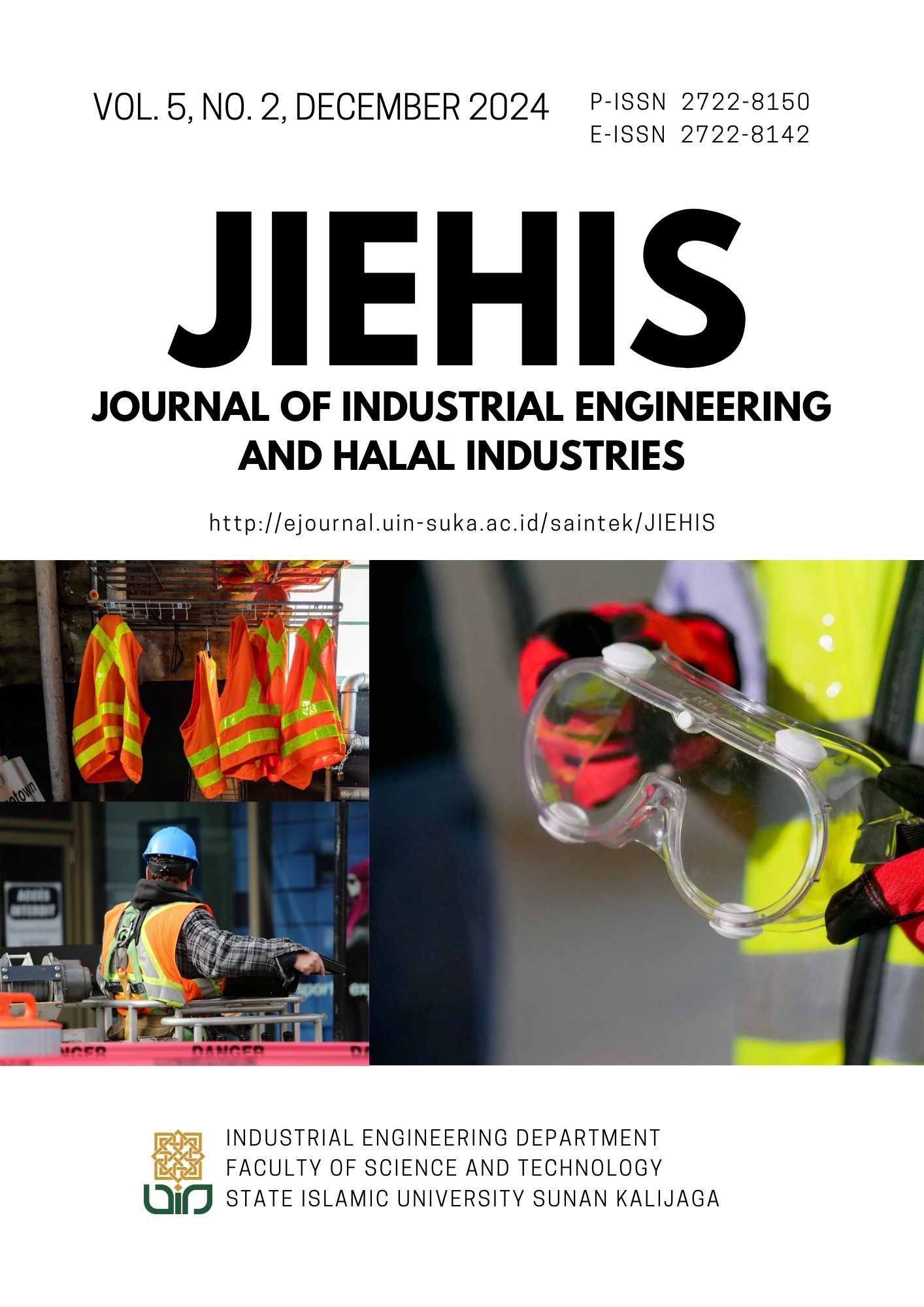The Overall Labor Effectiveness (OLE) Method for Analyzing Employee Performance in the Musical Instrument Industry
Overall Labor Effectiveness (OLE) Method for Analyzing Employee Performance in the Musical Instrument Industry
DOI:
https://doi.org/10.14421/jiehis.4968Keywords:
Productivity; Overall Labor effectiveness; Analytical Hierarchy Process; Root Cause AnalysisAbstract
The production processes in the musical instrument industry are highly diverse, ranging from manual operations to full automation. The musical instrument industry examined in this study is predominantly characterized by manual production processes. In manual production, the role of operators is crucial in determining productivity levels. The Buffing Section is a workgroup within the painting department responsible for polishing components of musical instruments. Observations conducted from September to November revealed that the productivity of this group had not met the company’s target of 82%. Productivity was recorded at 70% in September, 77% in October, and 72% in November. To evaluate this condition, operator performance effectiveness was measured using the Overall Labor Effectiveness (OLE) method. OLE is used to assess labor productivity efficiency in manufacturing by examining the cumulative impact of three elements—availability, performance, and quality—on output. To identify the priority factors affecting productivity, the Analytical Hierarchy Process (AHP) method was employed. Additionally, Root Cause Analysis (RCA) was conducted to analyze the causes of problems and propose improvements. The results of the study showed an OLE value of 76%, indicating that the operational performance effectiveness was below the global standard. AHP analysis revealed that the primary factor influencing the low OLE value, which should be prioritized for problem analysis and improvement, was the quality factor, with an eigenvector value of 0.70. To further identify quality-related issues, RCA analysis highlighted the most dominant defects based on a Pareto diagram, namely rough surfaces (69.74%) and dull finishes (15.61%). The primary causes of these defects were, Uneven operator skills, Improper machine settings, Inadequate sanding processes, Incorrect pressure during the buffing process, Excessive or insufficient use of wax, Poor workplace cleanliness
References
Anjani, R., & Pratiwi, I. (2021). Analisis Efektivitas Tenaga Kerja di Masa New Normal pada Departemen Finishing Menggunakan Overall Labor Effectiveness (OLE) (PT Iskandar Indah Printing Textile, Surakarta). Seminar Nasional Teknik Dan Manajemen Industri, 1(1), 232–239. https://doi.org/10.28932/sentekmi2021.v1i1.80
Bonci, A., Stadnicka, D., & Longhi, S. (2022). The Overall Labour Effectiveness to Improve Competitiveness and Productivity in Human-Centered Manufacturing (pp. 144–155). https://doi.org/10.1007/978-3-030-99310-8_12
Brabec, Z., & Jáčová, H. (2022). Overall Labor Effectiveness as a Tool for Measuring Performance in a Given Company. ACC Journal, 28(2), 7–18. https://doi.org/10.15240/tul/004/2022-2-001
Devani, V., & Syafruddin, S. (2018). USULAN PENINGKATAN EFEKTIVITAS TENAGA KERJA DENGAN MENGGUNAKAN METODE OVERALL LABOR EFFECTIVENESS. Jurnal Ilmiah Rekayasa Dan Manajemen Sistem Informasi, 4(2), 150. https://doi.org/10.24014/rmsi.v4i2.5684
Doggett, A. M. (2005). Root Cause Analysis: A Framework for Tool Selection. Quality Management Journal, 12(4), 34–45. https://doi.org/10.1080/10686967.2005.11919269
Hayat, A., & Rao, M. A. A. (2020). An Analytical Discourse on Islamic Precept of Ihsān and Labour Productivity. Journal of Islamic Thought and Civilization, 10(101), 136–155. https://doi.org/10.32350/jitc.101.07
Rahmadiani, P., & Kusrini, E. (2023). Operator Performance Analysis Using Overall Labor Effectiveness Method with Root Cause Analysis Approach. Asian Journal of Social and Humanities, 1(11), 918–927. https://doi.org/10.59888/ajosh.v1i11.106
Saaty, R. W. (1987). The analytic hierarchy process—what it is and how it is used. Mathematical Modelling, 9(3–5), 161–176. https://doi.org/10.1016/0270-0255(87)90473-8
Mangkuprawira, S., & Hubeis, A. V. (2023). Manajemen Mutu Sumber Daya Manusia. Ghalia Indonesia.
Suryoputro, M. R., Sugarindra, M., & Erfaisalsyah, H. (2017). Quality Control System using Simple Implementation of Seven Tools for Batik Textile Manufacturing. IOP Conference Series: Materials Science and Engineering, 215(1). https://doi.org/10.1088/1757-899X/215/1/012028
Tsehayae, A. A., & Fayek, A. R. (2016). System model for analysing construction labour productivity. Construction Innovation, 16(2), 203–228. https://doi.org/10.1108/CI-07-2015-0040
Wandahl, S., Pérez, C. T., Salling, S., Neve, H. H., Lerche, J., & Petersen, S. (2021). The Impact of Construction Labour Productivity on the Renovation Wave. Construction Economics and Building, 21(3). https://doi.org/10.5130/AJCEB.v21i3.7688
Downloads
Published
How to Cite
Issue
Section
License
Copyright (c) 2024 muchammad sugarindra

This work is licensed under a Creative Commons Attribution-ShareAlike 4.0 International License.
(c) The Author(s). This article is distributed under a Creative Commons Attribution-ShareAlike 4.0 International License.






